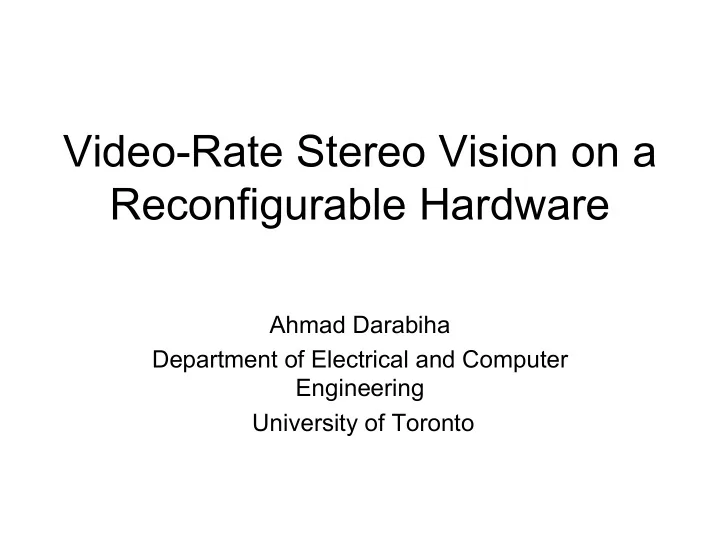

Video-Rate Stereo Vision on a Reconfigurable Hardware Ahmad Darabiha Department of Electrical and Computer Engineering University of Toronto
Introduction • What is “Stereo Vision”? “The ability of finding the depth information encoded within multiple images ” • Applications? - Robotics, Navigation - Security, Monitoring 2
Motivation • Problem • Real-time vision applications 30 frames/sec • Fastest software systems 5-10 seconds for each frame • Solution • Hardware implementation can accelerate the performance to video rate 3
Stereo Basics • f : focal length • T : distance between cameras • Disparity d = u – u’ • Distance Z = f T/d Top view 4
Example Left stereo system Depth map Right brighter �� closer How to find the corresponding points? 5
Correspondence Problem How to match corresponding points between the two images? Three methods: • Intensity-based • Match the pixels based on their intensity values Sensitive to brightness variations • Feature-based • Edges, corners, straight lines Can not produce dense disparity maps • Phase-based • Phase of filter outputs � Brightness invariant � Extracts more local texture 6
Local-Weighted Phase Correlation Algorithm • Adopted in our system • Phase-based • G2/H2 filters to extract the phase • Multi-resolution • Will reduce false matches • Three scales: 1,2 and 4 • Multi-orientation • Extracts more texture • Directions –45, 0, 45 degrees 7
Local-Weighted Phase Correlation Algorithm left image right image • Four major steps: Scaling Scaling 1. Scaling G2/H2 G2/H2 2. Orientation Decomposition Phase 3. Phase Correlation Correlation 4. Interpolation/ Peak- Detection Interpolation/ Peak detection Disparity map 8
Hardware Design
Hardware: ASIC or FPGA? ASIC (Application Specific Integrated Circuit) • Expensive and long design cycle • Preferred in mass production � FPGA (Field-Programmable Gate Array) • Less stringent design cycle • Less expensive • Can change the circuit “on the fly” 10
Transmogrifier-3A System ● Four interconnected Xilinx Virtex 2000E FPGAs ● Four external SRAM memory banks ● NTSC/VGA Video ports ● Four general I/O ports TM-3A system designed in UofT FPGA group 11
Design Overview Video Scale/Orientation Interface Unit Decomposition Unit Phase Interpolation/ Correlation Peak detection Unit Unit 12
Design Methodology Golden Golden version version Algorithm algorithm • Two design steps: 1 Matlab 1. Emulate hardware Golden functional behaviour Hardware version emulation in software Algorithm 2. Build the hardware 2 based on the Algorithm Golden emulation version VHDL version on Hardware Algorithm 13
Video Interface Unit • Input from two cameras in alternating frames • Output the original image to the display • Output the depth map results to the display 14
Scale/Orientation Decompositon Unit Response Phase Response Phase (+45 degree) (-45 degree) Scale 1 Scale 2 Scale 4 15
Filtering G2/H2 Filters are: • X_Y separable – O(n²) operations become O(2n) • Symmetrical – Reduces # of constant multipliers to half 16
Phase-Correlation Unit • Left and right images merged 17
Phase-Correlation Unit • Normalization block shared for all voting blocks • Voting block only 2 Multipliers, one adder and one Gaussian window 18
Interpolation/Peak detection Unit • Combine the voting results over all scales • Detect the index for the peak value in the overall voting result • Sub-pixel accuracy • fitting the the maximum value and its neighbours to a quadratic curve • Accuracy improved from 5 bits to 8 bits 19
Floating-point to fixed-point conversion • Fixed -point operations 8 7 required for efficient 6 Mean Square Error implementation 5 lamp Selected Width 4 books •Analysis is done for tree 3 every stage 2 1 •Efficient enough for 0 our system 4 6 8 10 12 Input width of the interpolation Unit 20
Results system m x n D T PDS Algorithm platform (pix.) (pix.) (msec) (million) INRIA 256 x 256 32 280 7.5 Intensity 23 Xilinx XC3090 correlation PARTS 240 x 320 24 23.8 77 Census 16 Xilinx 4025 CMU 200 x 200 30 33 36 Sum of abs. custom hardware difference This 256 x 360 20 33 55 LWPC 4 Xilinx V2000E Work m x n : Image Size (pixels) PDS = m.n.D / T D : Maximum disparity (pixels) T : Total time for each frame 21
Results: Random Stereograms left right Ground Truth (3D) Original Hardware Ground Truth Software Depth amp 22
Results: Natural Images 5 4 3 Ground Truth hardware Point 2 % Error # distance (cm) results (cm) Left input 1 300 309 3% 1 2 315 320 1.6% 3 320 276 13.7% Depth map 4 365 355 2.7% from hardware 5 410 402 1.9% 23
More Results depth map from input hardware 24
Conclusion • Video rate performance (30 frames/sec) • High accuracy phase-based stereo matching algorithm • Reprogrammability allows design expansions with minimum cost 25
Future Work • extensions to this system: • Post-processing blocks to validate the results • Using depth information from previous frame • Pre-processing blocks to rectify the images • Increase the search window size • Processing larger images • Other vision algorithms • Design automation tools 26
Recommend
More recommend